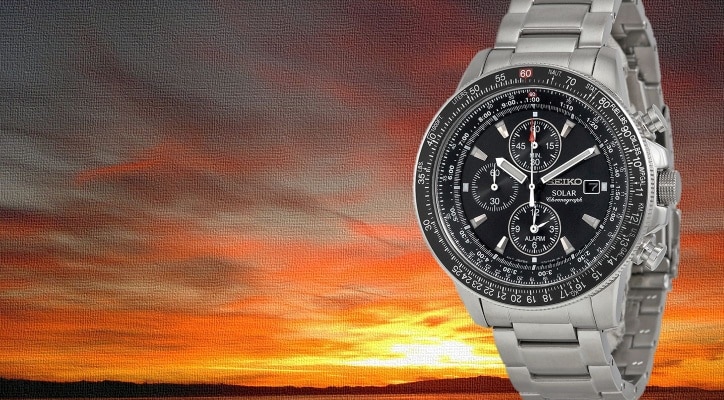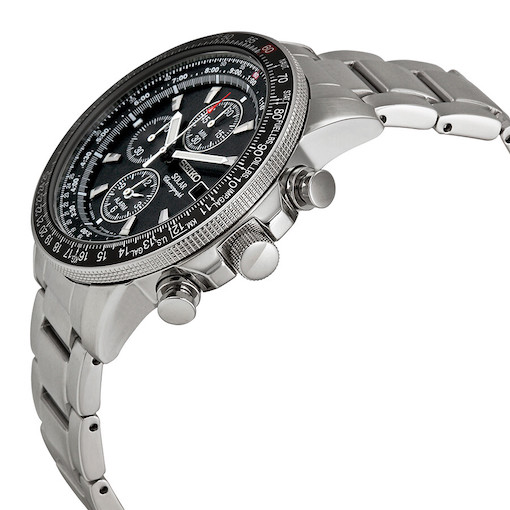
The 2011 Seiko Solar Pilot Alarm Chronograph SSC009 offers a loud alarm, a bidirectionally rotating Breitling-style slide-rule bezel, as well as a 60-minute chronograph accurate up to 1/5th of a second.
Basically, the dial of the new chronograph replicates layouts of other “flight computers” presented by Seiko in recent years.
The reason is simple: the new model, too, sports Seiko’s own Caliber V172 quartz movement. The V172 is one of their infamous “jewelless” calibers. The mechanism is often perceived to be of the “throw-away” kind, but that doesn’t mean that its ability to keep good time is somehow inferior to that of a tad more expensive mechanisms that feature *ahem* whole five or six stones that often provide support for parts cast of cheap plastic.
The Solar Pilot Chronograph sports a traditional alarm sub-dial, a small seconds indicator, as well as a 60-minute chronograph counter that are placed at 6, 9, and 12 o’clock respectively. At 9 o’clock, there is a standard date aperture.

The date window is traditionally small and it may be difficult to read for persons with poor eyesight.
There is also an opening for a built-in solar cell there (somewhere,) but you won’t be able to see it since the black dial is practically non-transparent. Frankly speaking, I have no idea how the Japanese engineers managed to create a solar-powered watch that has no visible photovoltaic panel, however tiny it is.
By the way, according to official specifications, while fully charged, the watch can work in total darkness for as long as six months! And in case you forget to recharge it, there is a power depletion alert that will notify you when the watch will be about to stop.
Well, if you suddenly went for a year-long trip around the world and forgot the timepiece either in its box or simply in your chest of drawers, then it’s probably a case of tough luck. However, if you simply leave the watch on your desk or some other place with plenty of ambient lighting, you are probably good: it will be enough to keep the watch up and running when you came back home.

The traditional Breitling-inspired slide rule is also in its rightful place, although it is here mostly for decorative purposes: it is easier to use a converter in your cell phone than learn how to use the scale.
Traditionally, the Japanese watchmaker equipped its Solar Pilot Chronograph with a “Hardlex” crystal: a hardened mineral glass.
Although not as pleasant to look at as a sapphire crystal with proper anti-reflective treatment, and also more prone to scratches, Hardlex is nevertheless a lot tougher. The part will easily survive impacts that will shutter a sapphire crystal.
Although looking massive in the pictures (probably thanks to a rather thin stainless steel bracelet,) the watch is not particularly large measuring just 43 millimeters in diameter.
There is still no info regarding the price*, but I am almost sure that, when it will hit online stores, you will be able to grab your piece for less than 300 U.S. dollars. The retail price will possibly be set at around $450-$550*.
See also: Citizen Eco-Drive Satellite Wave limited edition
* UPDATE ON PRICING: The Japanese brand offered the watch at $395 MSRP, which makes it an interesting choice for a price-conscious customer, although some may be put off by the fact that it is NOT fully assembled in Japan: only the mechanism itself is crafted by Seiko, the rest of the piece is assembled in another part of the world (guess which one.)
Photos: Seiko / Jomashop
Seiko Solar Pilot Chronograph (ref. SSC009) specification
Price: $395 (MSRP)
Movement: Quartz, Caliber V172, solar-powered, Made in Japan
Functions: Hours, minutes, seconds, date, chronograph, alarm
Power reserve: 6 months
Case and Crown: Stainless steel
Bezel: Steel
Shape: Round
Size: 43.00 mm
Lug width: 20 mm
Case height: 12.00 mm
Dial: Black
Hour markers: Steel
Hands: Luminous
Water resistance: 100 meters
Strap: Stainless steel bracelet
Crystal: Hardlex
Back: Solid
